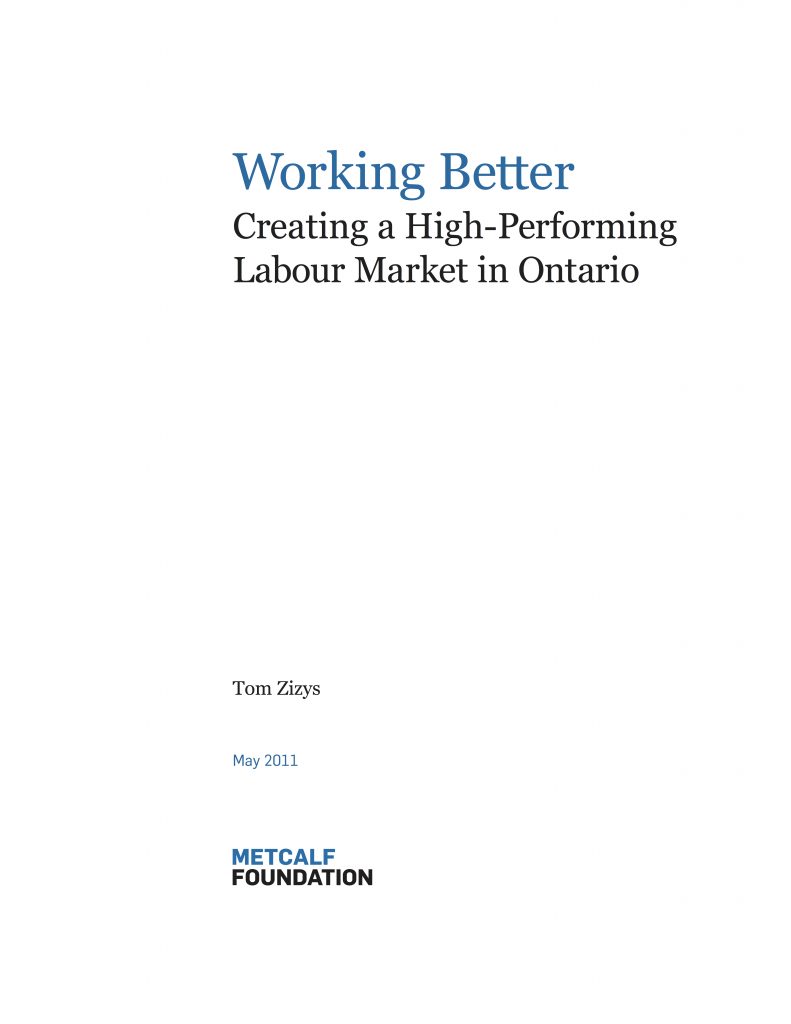Working Better: Creating a High-Performing Labour Market in Ontario presents a fresh accounting of the state of Ontario’s labour market and calls for a strategic overhaul. The report takes a look back over the past thirty years, describing a profound alteration in our labour market system. A thorough historical review and present-day analysis underline a significant change in the thinking and practices that define how work is organized and managed. Zizys’ research indicates that the current system is not serving anyone.
- Job seekers cannot find work in their chosen fields, are forced to compete against over-qualified candidates, or are limited to short-term, insecure roles.
- Employees are stuck in dead-end jobs with little pay, no loyalty, no job security, no room for advancement, and an unclear career path forward.
- Employers aren’t getting the people they need, aren’t keeping the ones they’ve got, and have low levels of productivity.
What motivated Zizys to undertake the research was a disconnect he saw between what workers and employers were experiencing. “Employers are saying that there’s a skills shortage, and yet we have one of the most highly educated workforces in the world,” he says. This “skills mismatch” is just one aspect of what he refers to as the “dysfunction” in the system. Also notable is the over-emphasis in our employment services on the deficiencies of the individual job-seeker, when the more pressing issues are navigating a fragmented labour market and maintaining a career path in a world of precarious work.
But most alarming is the trend toward a growing polarization between those at the top of the market in knowledge jobs and those at the bottom in entry-level jobs. While it is not news that middle-level jobs have been disappearing over the past thirty years, we are only just beginning to understand the implications. “When there was occupational mobility there was social mobility. Without this, we’re left with social exclusion. This equals bad economics and bad social policy,” says Zizys.
The report also refers to a cultural shift in mindset that was triggered by a new “mania” of cost-cutting in the 1980s. According to Zizys, we’ve come to accept without question that layoffs and continual labour cost reduction are the new normal and a necessary part of doing business. But, the report states, this is both false and damaging. Not only is it possible for companies to compete while investing in their workers, but to survive in a global marketplace, we will increasingly need to provide higher value-added goods and services, which calls for a skilled and engaged workforce. “A low-paid workforce is less likely to put the effort into producing high quality products and services, and they’re cash-strapped consumers too. It doesn’t make good business sense,” maintains Zizys.
The report makes clear that there are unavoidable reasons for these changes. Technological advances, globalization, and a socio-political shift away from the social welfare consensus are the new realities. But the response is something that we can control. It is Zizys’ hypothesis that the labour market system we have in place today has been haphazardly pieced together based on an old outdated model. With a deliberate, collaborative, and long-view strategy that responds to the current situation, the outcomes can improve for all. In short, what is needed is a new vision for a better labour market that will only come by bringing all stakeholders together. The elements of a new vision would include better labour market data and analysis, new strategies that move beyond economic development to include workforce development, and support for middle jobs.
The report suggests that a new system is not only possible, but that many of the answers are already within reach. Model practices are in play within specific sectors and organizations and in industrialized countries around the world. They only need to be mined and replicated.
Working Better is the first report to connect all the dots in the labour market system. “We’ve been keeping our eye on this issue for some time but what Tom has presented to us is a wakeup call. We hope that it is the first step to creating a new labour market system that will help Ontario reach its full potential,” says Sandy Houston, President of the Metcalf Foundation.
Related Materials & Media Coverage
Matching Skills With Jobs
CBC Radio, Metro Morning, Matt Galloway interviews report author Tom Zizys
May 10, 2011
Qualified But No Job
CBC Radio, Metro Morning, Matt Galloway interviews Jeff Roulston
May 11, 2011
Labour Market Changes Creates Disparity
The Toronto Star, Vanessa Lu
May 13, 2011
Why Talented Canadians Can’t Find Work
The Toronto Star, Carol Goar
May 19, 2011
Creating a High-Performing Labour Market in Ontario
Extra N.A., Francine Buchner
May 19, 2011
Ontario’s Labour Market Pains
The Agenda (TVO), Steve Paikin
June 13, 2011
Series: Working It Out — Tracking the jobs
The Barrie Examiner, Marg Bruineman
November 11, 2011
Moulding tomorrow’s employees today
The Barrie Examiner, Marg Bruineman
November 16, 2011
Ontario’s labour market, public policy and globalization: an interview with Tom Zizys
youth and work, Andrew Langille
January 16, 2012
60-plus workers represent 8 per cent of the workforce, but account for 30 per cent of new job gains
The Toronto Star, Vanessa Lu
February 24, 2012
Engineers and English majors: the jobs are calling
The Toronto Star, Jaclyn Tersigni
February 28, 2012
Cut deficits, boost productivity, business tells Ottawa
The Toronto Star, Dana Flavelle
March 26, 2012
Dude, where’s my pension plan?
The Grid, Jodie Shupac
June 20, 2012
How did we create such bleak job prospects for Canada’s youth?
The Toronto Star, Neil Sandell
November 30, 2012
Skilled Trades Shortage
CBC Radio Calgary, Calgary Eyeopener, Jennifer Keene talks to Tom Zizys in advance of the federal budget
March 21, 2013


